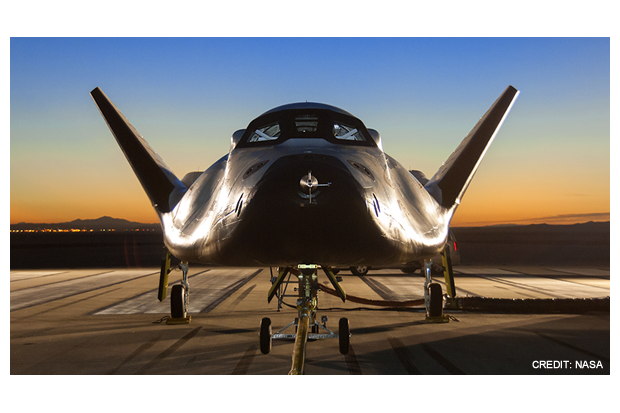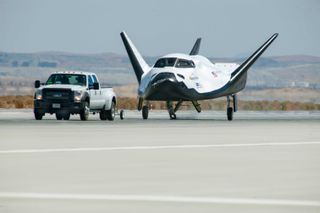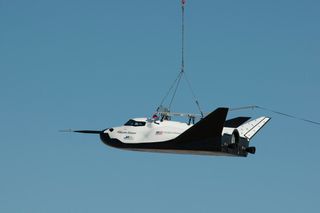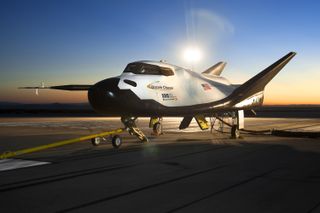
Government Shutdown Delays Major Private Space Plane Test

A key test flight of a new private space plane that aims to be a next-generation transportation vehicle for astronauts has become another casualty of the ongoing U.S. government shutdown.
The new commercial space plane, called Dream Chaser, was slated to make a major free-flight test slated on Oct. 5 at the NASA Dryden Flight Research Center, located inside Edwards Air Force Base in California. But because the government shutdown has shuttered most of NASA, Dream Chaser's debut unmanned drop test is now on hold.

"Our first vehicle is primed to take its test," said Mark Sirangelo, corporate vice president and head of Sierra Nevada Corporation's (SNC) Space Systems based in Louisville, Colo. "Right now we're basically on final, waiting for clearance to go ahead." [Photos of Dream Chaser, America's New Space Plane]
SNC is one of three companies — along with Space Exploration Technologies (SpaceX ) and The Boeing Company — funded under NASA’s Commercial Crew Integrated Capability (CCiCap) initiative to develop a next-generation crew transportation vehicle. Of the trio of spacecraft, Dream Chaser is the only reusable, lifting body vehicle with runway landing capability.
A winged spacecraft, Dream Chaser is designed to support space station crew transportation for NASA, international and commercial space applications. The space plane is designed to launch seven astronauts and cargo on missions to and from low-Earth orbit.
Ground, captive-carry tests
SNC engineers have put the Dream Chaser prototype through a series of ground and captive-carry tests to set the stage for the now-stalled unpiloted approach-and-landing drop.
Get the Space.com Newsletter
Breaking space news, the latest updates on rocket launches, skywatching events and more!
"It has been a lot of work," Sirangelo told SPACE.com.
The first Dream Chaser test vehicle has been at NASA's Dryden Flight Research Center since mid-May. It has already completed ground-based taxi and tow tests, evaluated the performance of its main landing gear and completed a flight test readiness review.
That was followed by a successful two-hour captive-carry test of Dream Chaser at Dryden on Aug. 22. During that test, the craft dangled under an Erickson Air-Crane helicopter.

That assessment cleared several of the Dream Chaser systems and sub-systems prior to the upcoming free-flight test, Sirangelo told SPACE.com. Software was also tested that included flight computer, guidance, navigation and control, the vehicle's control surfaces, and the landing gear and nose skid, which was deployed during the helicopter hoisting flight.
Dream Chaser team in limbo
The closing of Dryden due to the government shutdown has meant some 50 to 60 Dream Chaser team members being placed in limbo, Sirangelo said.
"Not having access to the NASA facilities certainly delays the execution of parts of the program," he added. "But there’s nothing we can do about it. I don't think anybody can do anything about it right now."
Even a government back-to-work go-ahead would mean readying the Dream Chaser and the team for the drop test, a situation that would likely take a week of time, Sirangelo said.
"But it's not about the vehicle anymore. It's about the logistics of flying," Sirangelo added. "This was not on my contingency list. I thought I had thought of everything."
Sirangelo said Dream Chaser went to Dryden and Edwards because it was the right place to be and that's where America should test its space planes. "But we didn't think it would come back and haunt us," he said.

Dream Chaser milestones and money
Under the NASA CCiCap, the Dream Chaser work doesn't mean the private company is billing NASA every month for its time on the project.
"We get paid later when we complete the milestone," Sirangelo said. "We're funding more time, if you will, on the money."
On an upbeat note, Sirangelo said that nobody is thinking the government shutdown will go on forever. "It's just a delay a few weeks in my mind."
Furthermore, Sirangelo said that SNC is not standing still and is busy at work on future Dream Chaser plans.
"Things have gone well and we're ready to fly … and we expect to be flying this year," he said.
Leonard David has been reporting on the space industry for more than five decades. He is former director of research for the National Commission on Space and is co-author of Buzz Aldrin's new book "Mission to Mars – My Vision for Space Exploration" published by National Geographic. Follow us @Spacedotcom, Facebook and Google+. Original article on SPACE.com.
Join our Space Forums to keep talking space on the latest missions, night sky and more! And if you have a news tip, correction or comment, let us know at: community@space.com.

Leonard David is an award-winning space journalist who has been reporting on space activities for more than 50 years. Currently writing as Space.com's Space Insider Columnist among his other projects, Leonard has authored numerous books on space exploration, Mars missions and more, with his latest being "Moon Rush: The New Space Race" published in 2019 by National Geographic. He also wrote "Mars: Our Future on the Red Planet" released in 2016 by National Geographic. Leonard has served as a correspondent for SpaceNews, Scientific American and Aerospace America for the AIAA. He has received many awards, including the first Ordway Award for Sustained Excellence in Spaceflight History in 2015 at the AAS Wernher von Braun Memorial Symposium. You can find out Leonard's latest project at his website and on Twitter.










